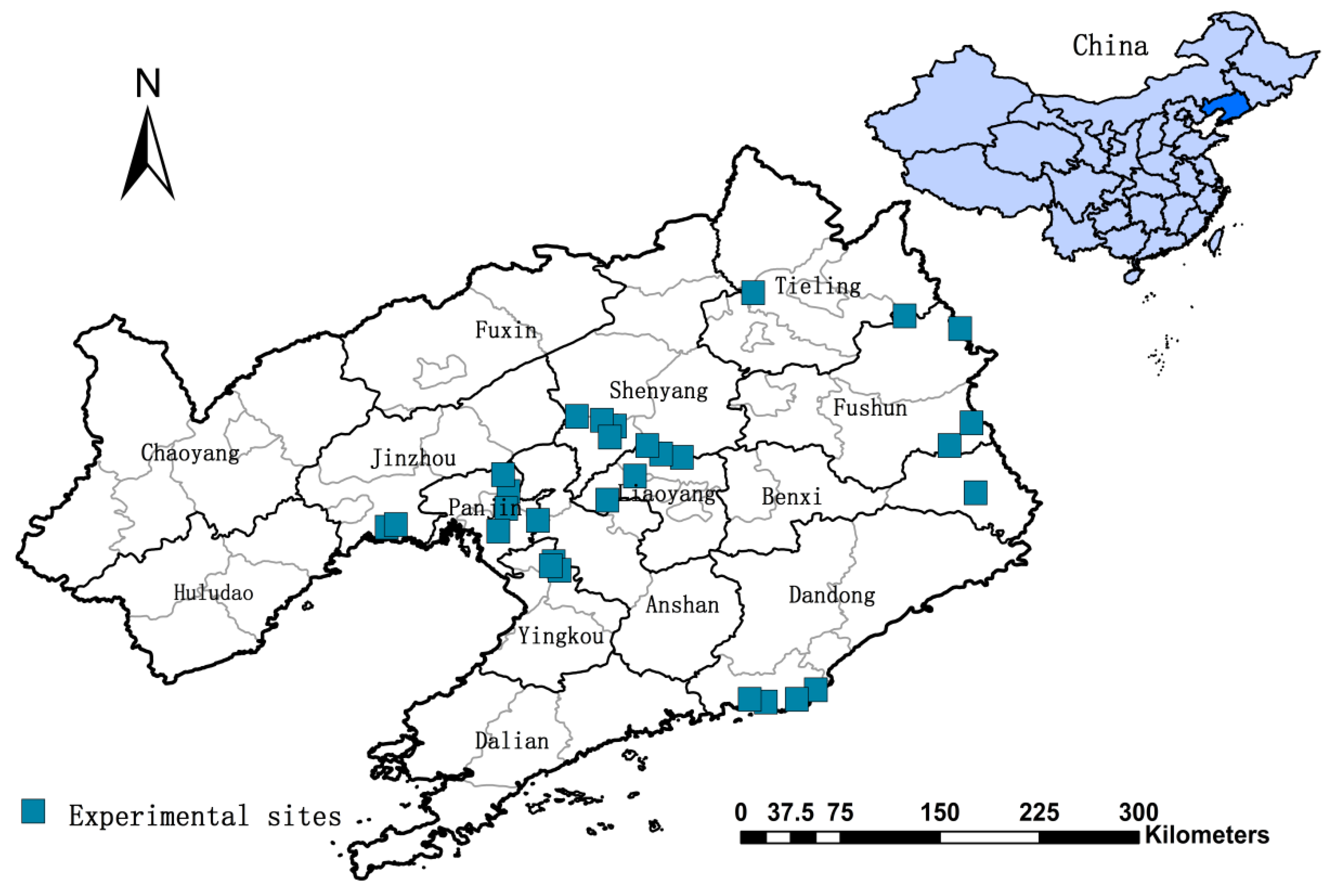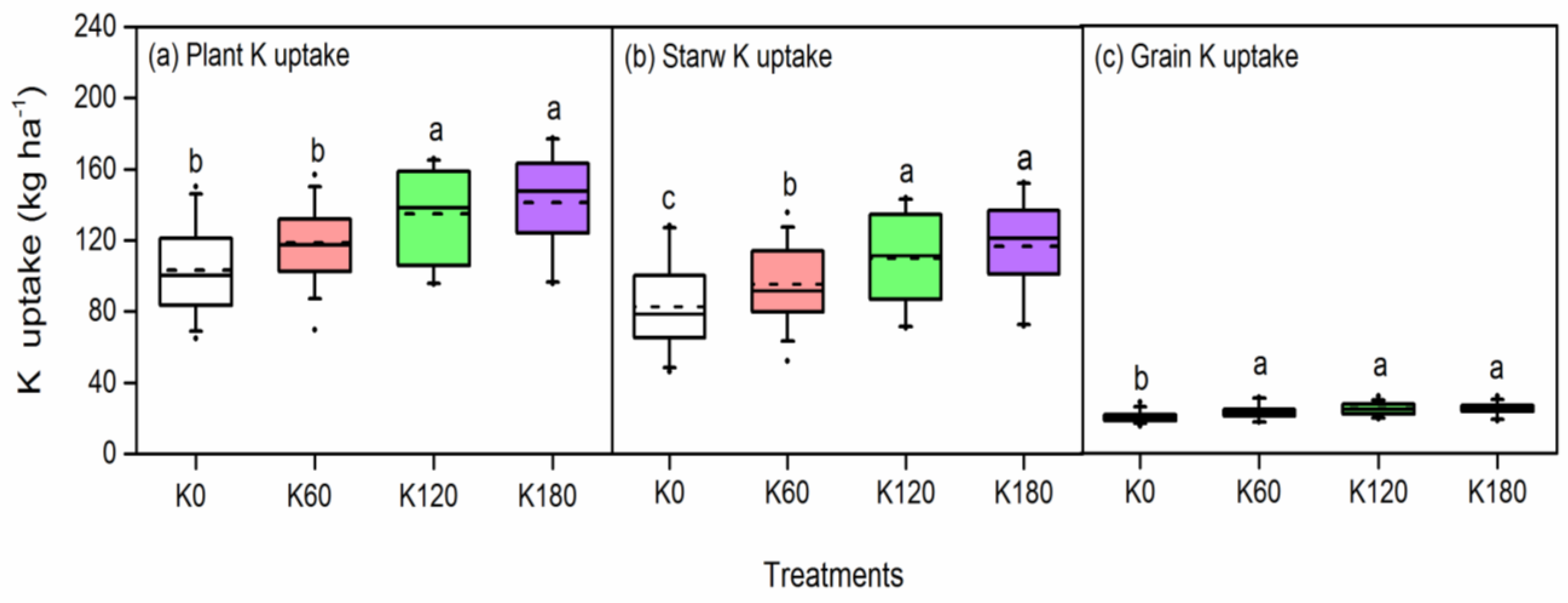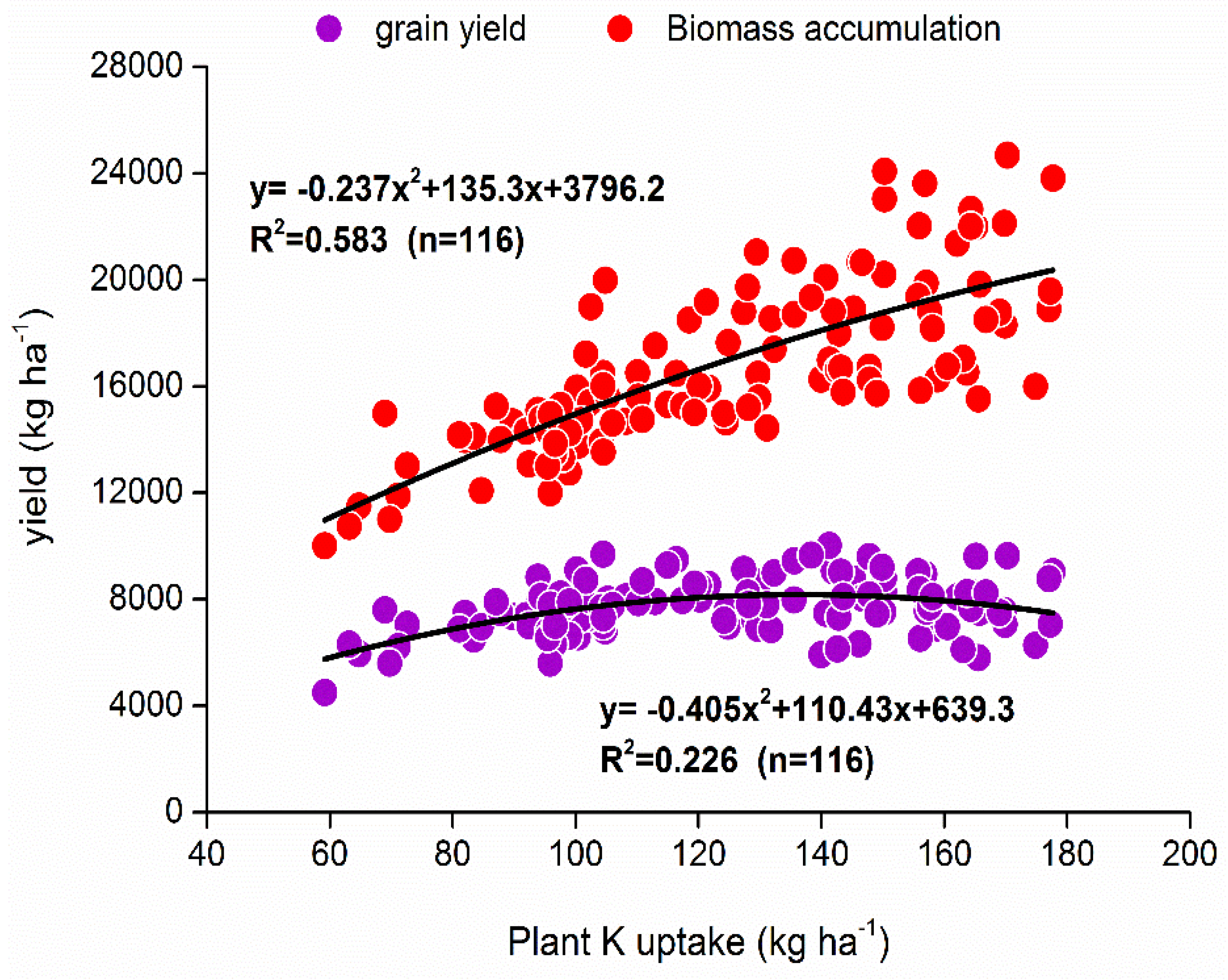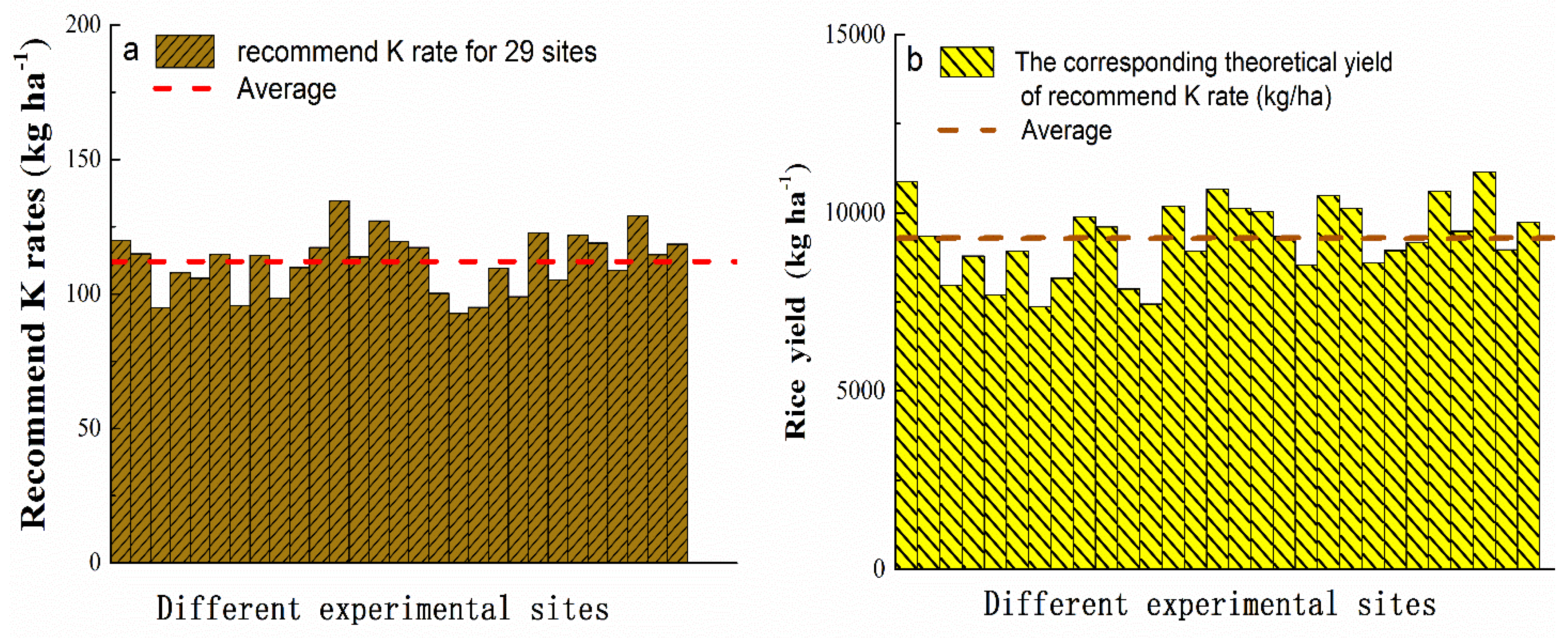Enhancing Rice Production by Potassium Management: Recommended Reasonable Fertilization Strategies in Different Inherent Soil Productivity Levels for a Sustainable Rice Production System
Abstract
1. Introduction
2. Materials and Methods
2.1. Data Source and Site Description
2.2. Experimental Design and Management
2.3. Measurements
2.4. Caculation
2.5. Fertilizer Recommendation in Inherent Soil Productivity Levels
Fertilizer Recommendation Used by the Quadratic Regression Model
2.6. Statistical Analysis
3. Results and Discussion
3.1. Increasing Yield to Applied K Levels
3.2. Potassium Uptake of the Plant, Straw and Grain in Different K Application Levels
3.3. Correlation Among Biomass Accumulation, Grain Yield, and Plant K Uptake
3.4. Potassium Contribution Rates (FCRK)
3.5. Fertilizer Recommendation of Rice for Sustainability Agriculture
3.6. Recommended K Rates in Different Inherent Soil Productivity and Crop Management Styles
4. Conclusions
Author Contributions
Funding
Conflicts of Interest
References
- Li, P.; Lu, J.; Wang, Y.; Wang, S.; Hussain, S.; Ren, T.; Cong, R.; Li, X. Nitrogen losses, use efficiency, and productivity of early rice under controlled-release urea. Agric. Ecosyst. Environ. 2018, 251, 78–87. [Google Scholar] [CrossRef]
- Gu, J.; Jing, C.; Lu, C.; Wang, Z.; Hao, Z.; Yang, J. Grain quality changes and responses to nitrogen fertilizer of japonica rice cultivars released in the Yangtze River Basin from the 1950s to 2000s. Crop J. 2015, 3, 285–297. [Google Scholar] [CrossRef]
- Charles, H.; Godfray, J.; Beddington, J.R.; Crute, I.R.; Haddad, L.; Lawrence, D.; Muir, J.F.; Robinson, S.; Thomas, S.M. Food Security: The challenge of feeding 9 billion people. Science 2010, 327, 812–818. [Google Scholar]
- Zhang, H.; Xu, M.; Shi, X.; Li, Z.; Huang, Q.; Wang, X. Rice yield, potassium uptake and apparent balance under long-term fertilization in rice-based cropping systems in southern China. Nutr. Cycl. Agroecosyst. 2010, 88, 341–349. [Google Scholar] [CrossRef]
- Zhang, H.; Liu, H.; Hou, D.; Zhou, Y.; Liu, M.; Wang, Z.; Liu, L.; Gu, J.; Yang, J. The effect of integrative crop management on root growth and methane emission of paddy rice. Crop J. 2019, 7, 444–457. [Google Scholar] [CrossRef]
- Sinebo, W. Yield Relationships of barleys grown in a tropical highland environment. Crop Sci. 2002, 42, 428–437. [Google Scholar] [CrossRef]
- Li, G.; Zhang, J.; Yang, C.; Song, Y.; Zheng, C.; Wang, S.; Liu, Z. Optimal yield-related attributes of irrigated rice for high yield potential based on path analysis and stability analysis. Crop J. 2014, 2, 235–243. [Google Scholar] [CrossRef][Green Version]
- Xue, Y.; Hua, D.; Liu, L.; Wang, Z.; Yang, J.; Zhang, J. An Improved Crop Management Increases Grain Yield and Nitrogen and Water Use Efficiency in Rice. Crop Sci. 2013, 53, 271–284. [Google Scholar] [CrossRef]
- Zhang, H.; Yu, C.; Kong, X.; Hou, D.; Gu, J.; Liu, L.; Wang, Z.; Yang, J. Progressive integrative crop managements increase grain yield, nitrogen use efficiency and irrigation water productivity in rice. Field Crop. Res. 2018, 215, 1–11. [Google Scholar] [CrossRef]
- Fan, M.; Shen, J.; Yuan, L.; Jiang, R.; Chen, X.; Davies, W.J.; Zhang, F. Improving crop productivity and resource use efficiency to ensure food security and environmental quality in China. J. Exp. Bot. 2012, 63, 13–24. [Google Scholar] [CrossRef]
- Min, H.; Zhou, X.; Zou, Y. Improving nitrogen management for zero-tillage rice in China. Crop J. 2018, 6, 406–412. [Google Scholar]
- Galloway, J.N.; Townsend, A.R.; Erisman, J.W.; Bekunda, M.; Cai, Z.C.; Freney, J.R.; Martinelli, L.A.; Seitzinger, S.P.; Sutton, M.A. Transformation of the nitrogen cycle: Recent trends, questions, and potential solutions. Science 2008, 320, 889–892. [Google Scholar] [CrossRef] [PubMed]
- Jiang, W.T.; Liu, X.H.; Wang, Y.; Zhang, Y.; Qi, W. Responses to Potassium Application and Economic Optimum K Rate of Maize under Different Soil Indigenous K Supply. Sustainability 2018, 10, 2267. [Google Scholar] [CrossRef]
- Guo, J.H.; Liu, X.J.; Zhang, Y.; Shen, J.L.; Han, W.X.; Zhang, W.F.; Christie, P.; Goulding, K.W.; Vitousek, P.M.; Zhang, F.S. Significant acidification in major Chinese croplands. Science 2010, 327, 1008–1010. [Google Scholar] [CrossRef]
- Ma, Y.C.; Kong, X.W.; Yang, B.; Zhang, X.L.; Yan, X.Y.; Yang, J.C.; Xiong, Z.Q. Net global warming potential and greenhouse gas intensity of annual rice–wheat rotations with integrated soil–crop system management. Agric. Ecosyst. Environ. 2013, 164, 209–219. [Google Scholar] [CrossRef]
- Wang, M.; Zheng, Q.; Shen, Q.; Guo, S. The Critical Role of Potassium in Plant Stress Response. Int. J. Mol. Sci. 2013, 14, 7370–7390. [Google Scholar] [CrossRef]
- Zorb, C.; Senbayram, M.; Peiter, E. Potassium in agriculture-status and perspectives. J. Plant Physiol. 2014, 171, 656–669. [Google Scholar] [CrossRef]
- Trivedi, K.; Kubavat, D.; Ghara, K.K.; Kumar, R.; Trivedi, H.; Anand, K.G.V.; Maiti, P.; Ghosh, A. Evaluation of Fertilizer Potential of Different K Compounds Prepared Utilizing Sea Bittern as Feed Stock. Front. Plant Sci. 2017, 8, 1541–1553. [Google Scholar] [CrossRef]
- Cong, R.; Li, H.; Zhang, Z.; Ren, T.; Li, X.; Lu, J. Evaluate regional potassium fertilization strategy of winter oilseed rape under intensive cropping systems: Large-scale field experiment analysis. Field Crop. Res. 2016, 193, 34–42. [Google Scholar] [CrossRef]
- He, P.; Yang, L.; Xu, X.; Zhao, S.; Chen, F.; Li, S.; Tu, S.; Jin, J.; Johnston, A.M. Temporal and spatial variation of soil available potassium in China (1990–2012). Field Crop. Res. 2015, 173, 49–56. [Google Scholar] [CrossRef]
- Wang, X.K.; Fan, J.L.; Xing, Y.Y.; Xu, G.C.; Wang, H.D.; Deng, J.; Wang, Y.F.; Zhang, F.C.; Li, P.; Li, Z.B. The effects of mulch and nitrogen fertilizer on the soil environment of crop plants. Adv. Agron. 2019, 153, 121–173. [Google Scholar]
- Wu, L.; Ma, W.; Zhang, C.; Wu, L.; Zhang, W.; Jiang, R.; Zhang, F.; Cui, Z.; Chen, X. Current potassium management status and grain yield response of Chinese maize to potassium application. J. Plant Nutr. Soil Sci. 2013, 176, 441–449. [Google Scholar] [CrossRef]
- Zhang, R.X.; Liu, X.Z.; Wang, W.N.; Wang, Y.Z.; Li, H.; Zhang, Z.X.; Xu, Q. Study on the application effects of N,P, and K fertilizers on rice and the recommended fertilizer amount in eastern Huibei. J. Hubei Agric. Sci. 2009, 13, 35–38. (In Chinese) [Google Scholar]
- FAO (Food and Agriculture Organization of the United Nations). FAOSTAT Database—Agricultural Production; FAO: Rome, Italy, 2012. [Google Scholar]
- Xu, X.P.; Xie, J.G.; Hou, Y.P.; He, P.; Pampolino, M.F.; Zhao, S.C.; Zhou, W. Estimating nutrient uptake requirements for rice in China. Field Crop. Res. 2015, 180, 37–45. [Google Scholar] [CrossRef]
- Liao, Y.L.; Lu, Y.H.; Xie, J.; Nie, J.; Yang, Z.P.; Zhou, X. Effects of Long-term application of chemical potassium fertilizer and incorporation of rice straw on potassium supplying capacity of red soil in double cropping paddy field. Acta Pedol. Sin. 2017, 54, 456–466. (In Chinese) [Google Scholar]
- Qiu, S.; Xie, J.; Zhao, S.; Xu, X.; Hou, Y.; Wang, X.; Zhou, W.; He, P.; Johnston, A.M.; Christie, P. Long-term effects of potassium fertilization on yield, efficiency, and soil fertility status in a rain-fed maize system in northeast China. Field Crop. Res. 2014, 163, 1–9. [Google Scholar] [CrossRef]
- Chen, Y.; Li, Y.; Hu, D.; Zhang, X.; Wen, Y.; Chen, D. Spatial distribution of potassium uptake across the cotton plant affects fiber length. Field Crop. Res. 2016, 192, 126–133. [Google Scholar] [CrossRef]
- Chuan, L.; He, P.; Jin, J.; Li, S.; Grant, C.; Xu, X.; Qiu, S.; Zhao, S.; Zhou, W. Estimating nutrient uptake requirements for wheat in China. Field Crop. Res. 2013, 146, 96–104. [Google Scholar] [CrossRef]








| Treatments | Potassium Fertilizer Contribution Rates (%) | |||||
|---|---|---|---|---|---|---|
| Mean | SD | Min | 25%Qb | 75%Qb | Max | |
| K60 | 8.11 | 3.29 | 4.07 | 5.48 | 9.50 | 19.55 |
| K120 | 14.29 | 5.46 | 6.40 | 9.33 | 18.04 | 28.55 |
| K180 | 7.30 | 4.48 | 0.48 | 3.70 | 10.38 | 19.70 |
| Experimental Sites | Y = a + bx + cx2 | R2 | Experimental Sites | Y = a + bx + cx2 | R2 |
|---|---|---|---|---|---|
| Site 1 | y = 8052.8 + 23.48x − 0.098x2 | 0.951 ** | Site 16 | y = 7228.8 + 24.62x − 0.105x2 | 0.839 ** |
| Site 2 | y = 6757.7 + 22.51x − 0.0098x2 | 0.908 ** | Site 17 | y = 8824.5 + 12.02x − 0.06x2 | 0.984 ** |
| Site 3 | y = 6966.5 + 10.62x − 0.056x2 | 0.938 ** | Site 18 | y = 8003.4 + 14.47x − 0.078x2 | 0.978 ** |
| Site 4 | y = 7586.8 + 10.38x − 0.045x2 | 0.959 ** | Site 19 | y = 7059.6 + 15.58x − 0.082x2 | 0.998 ** |
| Site 5 | y = 5752.8 + 18.61x − 0.088x2 | 0.794 ** | Site 20 | y = 8202.4 + 20.81x − 0.095x2 | 0.674 ** |
| Site 6 | y = 7366.7 + 13.53x − 0.059x2 | 0.991 ** | Site 21 | y = 7896.2 + 22.56x − 0.114x2 | 0.983 ** |
| Site 7 | y = 5941.4 + 14.93x − 0.078x2 | 0.746 ** | Site 22 | y = 6247 + 19.15x − 0.078x2 | 0.757 ** |
| Site 8 | y = 6512.1 + 14.4x − 0.063x2 | 0.754 ** | Site 23 | y = 7468.4 + 13.89x − 0.057x2 | 0.988 ** |
| Site 9 | y = 7287 + 26.37x − 0.134x2 | 0.603 ** | Site 24 | y = 8455.5 + 18.06x − 0.076x2 | 0.589 ** |
| Site 10 | y = 6454.5 + 28.75x − 0.131x2 | 0.943 ** | Site 25 | y = 8455.5 + 18.06x − 0.076x2 | 0.943 ** |
| Site 11 | y = 4454.5 + 29.07x − 0.124x2 | 0.969 ** | Site 26 | y = 7231.3 + 20.65x − 0.095x2 | 0.92 ** |
| Site 12 | y = 5918 + 11.3x − 0.042x2 | 0.908 ** | Site 27 | y = 7214.6 + 30.44x − 0.118x2 | 0.786 ** |
| Site 13 | y = 6823.1 + 29.59x − 0.13x2 | 0.939 ** | Site 28 | y = 6157.3 + 24.52 − 0.107x2 | 0.901 ** |
| Site 14 | y = 6979.8 + 15.25x − 0.06x2 | 0.911 ** | Site 29 | y = 6874.6 + 24.16x − 0.102x2 | 0.874 ** |
| Site 15 | y = 9057.4 + 13.38x − 0.056x2 | 0.862 ** |
| Different Inherent Soil Productivity Levels | Item | Optimal Recommended K Rate | The Corresponding Theoretical Yield |
|---|---|---|---|
| L1 | Mean | 116.1 | 9966.1 |
| Max | 113.8 | 9738.3 | |
| Min | 118.5 | 10193.8 | |
| L2 | Mean | 111.2 | 10158.8 |
| Max | 92.8 | 9161.5 | |
| Min | 129.0 | 11144.5 | |
| L3 | Mean | 112.2 | 8373.2 |
| Max | 94.8 | 7371.5 | |
| Min | 134.5 | 9604.0 | |
| L4 | Mean | 111.7 | 8881.9 |
| Max | 105.1 | 8785.1 | |
| Min | 115.4 | 8940.0 |
© 2019 by the authors. Licensee MDPI, Basel, Switzerland. This article is an open access article distributed under the terms and conditions of the Creative Commons Attribution (CC BY) license (http://creativecommons.org/licenses/by/4.0/).
Share and Cite
Jiang, W.; Wang, X.; Xing, Y.; Liu, X.; Cui, Z.; Yang, L. Enhancing Rice Production by Potassium Management: Recommended Reasonable Fertilization Strategies in Different Inherent Soil Productivity Levels for a Sustainable Rice Production System. Sustainability 2019, 11, 6522. https://doi.org/10.3390/su11226522
Jiang W, Wang X, Xing Y, Liu X, Cui Z, Yang L. Enhancing Rice Production by Potassium Management: Recommended Reasonable Fertilization Strategies in Different Inherent Soil Productivity Levels for a Sustainable Rice Production System. Sustainability. 2019; 11(22):6522. https://doi.org/10.3390/su11226522
Chicago/Turabian StyleJiang, Wenting, Xiukang Wang, Yingying Xing, Xiaohu Liu, Zhigang Cui, and Lihui Yang. 2019. "Enhancing Rice Production by Potassium Management: Recommended Reasonable Fertilization Strategies in Different Inherent Soil Productivity Levels for a Sustainable Rice Production System" Sustainability 11, no. 22: 6522. https://doi.org/10.3390/su11226522
APA StyleJiang, W., Wang, X., Xing, Y., Liu, X., Cui, Z., & Yang, L. (2019). Enhancing Rice Production by Potassium Management: Recommended Reasonable Fertilization Strategies in Different Inherent Soil Productivity Levels for a Sustainable Rice Production System. Sustainability, 11(22), 6522. https://doi.org/10.3390/su11226522






